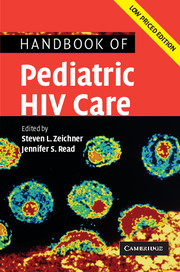Book contents
- Frontmatter
- Contents
- List of contributors
- List of abbreviations
- Foreword
- Preface
- Part I Scientific basis of pediatric HIV care
- Part II General issues in the care of pediatric HIV patients
- Part III Antiretroviral therapy
- Part IV Clinical manifestations of HIV infection in children
- 18 Cutaneous diseases
- 19 Neurologic problems
- 20 Ophthalmic problems
- 21 Oral health and dental problems
- 22 Otitis media and sinusitis
- 23 Cardiac problems
- 24 Pulmonary problems
- 25 Hematologic problems
- 26 Gastrointestinal disorders
- 27 Renal disease
- 28 Endocrine disorders
- 29 Neoplastic disease in pediatric HIV infection
- Part V Infectious problems in pediatric HIV disease
- Part VI Medical, social, and legal issues
- Appendix 1 Formulary of antiretroviral agents
- Appendix 2 National Institutes of Health sponsored clinical trials for pediatric HIV disease
- Appendix 3 Selected HIV-related internet resources
- Appendix 4 Selected legal resources for HIV-infected children
- Index
- References
26 - Gastrointestinal disorders
Published online by Cambridge University Press: 23 December 2009
- Frontmatter
- Contents
- List of contributors
- List of abbreviations
- Foreword
- Preface
- Part I Scientific basis of pediatric HIV care
- Part II General issues in the care of pediatric HIV patients
- Part III Antiretroviral therapy
- Part IV Clinical manifestations of HIV infection in children
- 18 Cutaneous diseases
- 19 Neurologic problems
- 20 Ophthalmic problems
- 21 Oral health and dental problems
- 22 Otitis media and sinusitis
- 23 Cardiac problems
- 24 Pulmonary problems
- 25 Hematologic problems
- 26 Gastrointestinal disorders
- 27 Renal disease
- 28 Endocrine disorders
- 29 Neoplastic disease in pediatric HIV infection
- Part V Infectious problems in pediatric HIV disease
- Part VI Medical, social, and legal issues
- Appendix 1 Formulary of antiretroviral agents
- Appendix 2 National Institutes of Health sponsored clinical trials for pediatric HIV disease
- Appendix 3 Selected HIV-related internet resources
- Appendix 4 Selected legal resources for HIV-infected children
- Index
- References
Summary
Introduction
Gastrointestinal (GI) dysfunction, a common occurrence in children with HIV disease, can be related to infectious agents, malnutrition, immunodeficiency or HIV infection itself, and can result in retardation of growth, increased caloric requirements, and/or diarrhea/malabsorption. The absorption and utilization of nutrients is a primary function of the GI tract, but the immune system of the gut has been shown to be the major site of CD4+ lymphocyte depletion and viral replication [1]. The mucosal immune and enteric nervous systems interact with the epithelium to regulate intestinal function. Lymphocytes and macrophages produce cytokines and vasoactive peptides that can alter brush border epithelial cell enzyme expression, secretion, motility or mucosal blood flow. These factors ultimately affect nutrient absorption. As immune function deteriorates in the HIV-infected child, intestinal function declines to a degree greater than might be expected due to opportunistic infections alone. The goal of this chapter is to present the GI aspects of HIV disease so that clinicians will begin intervention in the early stages of the disease, thereby minimizing the impact on growth and development.
GI problems of HIV-infected children
During acute infection with HIV, GI symptoms are rare. Older children can experience a “flu-like” illness, but most infants infected through MTCT are asymptomatic. One of the earliest clinical manifestations of HIV infection in children is growth retardation and slow weight gain. These changes in growth can occur as early as two months of age and do not appear to be related to concomitant, e.g., opportunistic, infection [2–4].
- Type
- Chapter
- Information
- Handbook of Pediatric HIV Care , pp. 602 - 617Publisher: Cambridge University PressPrint publication year: 2006



